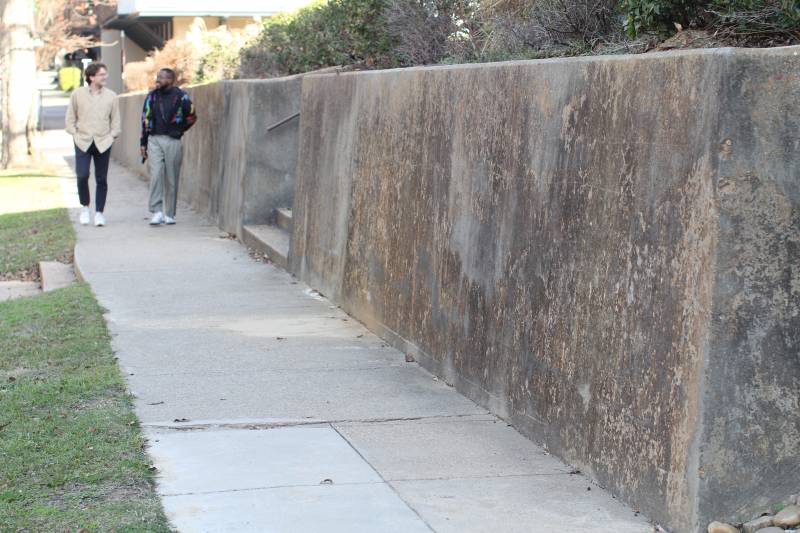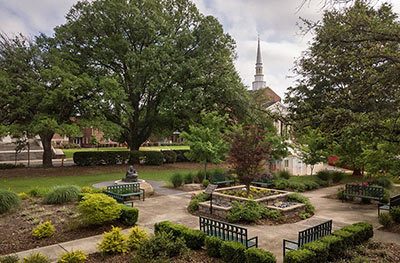Proposed Jefferson Street Mosaic to Emphasize Clinton, MC’s ‘Town and Gown’ Relationship

For years, Tara Lytal would pass the long retaining wall on Jefferson Street in the heart of Olde Towne Clinton and think, “That would be a great place for a mosaic.”
The director of Main Street Clinton wasn’t alone. Randy Jolly took one look at the massive 110-foot-long surface and envisioned a blank canvas that could depict the city’s symbiotic “Town and Gown” relationship with the state’s oldest institution of higher learning.
“There’s a strong relationship between Mississippi College and Clinton,” the instructor in the Department of Art and director of the Gore Galleries – located directly across the street from the retaining wall – said. “The wall is located right where the city and the University meet on the Brick Streets.
“It’s the perfect place to have a message of the dual effort between the city and the college to move forward and make this a better, more livable place to bring your family and become a part of the community. That’s been our history, and we want an uplifting piece to communicate that message.”
In 2024, the longtime Clintonians may get their wish.
Members of the newly formed Clinton Public Art Committee – on which both Lytal and Jolly serve – have been working to secure art projects throughout town that raise the aesthetic appeal of Clinton. All that remains to transform the large gray wall into a masterpiece is for an artist to be selected and a design to be approved.
Lytal is excited for work to get underway.
“We’re in the preliminary stages of this project that will enhance the area and make people want to settle in, stay, and raise their families,” she said. “More than a photo op, the wall could tell our story to visitors with scenes that people could relate to.
“There has always been a relationship between MC and Clinton. If you go back decades, you will see that leaders from the University have also served as leaders in the community. They were our aldermen, our mayors, and so on. We never want to lose that strong connection, and this artwork will serve as another way to strengthen our relationship.”
In deference to those who blazed the city’s trail long before it acquired the name “Clinton,” the artwork should be influenced by the original inhabitants of the area, Jolly said.
“We’re looking at having the artist use some of the designs and patterns that you see repeated in native Choctaw basketry and jewelry,” he said. “It will also include images that represent the town of Clinton and the University.
“Since it’s going to be a rather large mosaic, the artist will have plenty of room to interpret several ideas taken from the committee, the school, and the community and present them as a unified image. Perhaps some art students from the local high schools and the University could collaborate with the artist to create a collaborative piece.”
Randy Miley, professor of art at MC, said he fully supports any efforts that the city of Clinton takes to place art in the community, particularly Olde Towne.
“It is great for our image and shows the public how much we feel that art is important in the community,” Miley said. “We have a rich repertoire of artists in this community, and it gives us a chance to showcase their talents and skills as artists.
“We also have good art programs in our schools. We are blessed – it is a win-win situation.”
Why choose a mosaic rather than a mural, admittedly a more traditional method of telling a city’s story in art? The committee looked overseas for the answer.
“It is a little different – there aren’t many places that have a large mosaic,” Lytal said. “When you think of the great cities throughout European history, they all had mosaics.
“The permanency of the work, the dimensional quality of it, are factors, too.”
Maintenance was also a consideration, Jolly said.
“To keep a mosaic up, all you have to do is occasionally clean it and repair the grout every few years,” he said. “It doesn’t peel away like a mural does. And since it’s an unusual medium, people will come to see a mosaic of that size.”
Although it originated in committee, the project got its biggest boost from MC leadership. President Blake Thompson gave his seal of approval in the fall, and surveyors measured the wall so prospective artists could submit accurate proposals.
“The committee is looking at artists who have done this type of work before,” Lytal said. “There are several great mosaic artists, but there’s a science to a project of this magnitude, and we want to make sure that the work will have the longevity we’re looking for.
“Clinton is home to some outstanding artwork. You’ve got Dr. (Samuel) Gore, Albert Smathers, and Wyatt Waters. Along with this mosaic, the committee wants to produce a publication that shows where all the wonderful public art is located in our community so visitors and residents can recognize what a great asset these works of art are in our community.”
Jolly said the mosaic would also benefit the Gore Galleries on Jefferson Street.
“Because of its proximity, the mosaic would boost attendance here,” he said. “If you’re here to see the mosaic, you can just walk across the street and see the gallery, which houses one of the largest collections of Mississippi artists’ work in the state.
“We’ve got some of the top noted artists in the state. We have pieces by Walter Anderson, Mildred and Karl Wolfe, Keith Francis, Bill Dunlap, Kenneth Quinn, Wyatt Waters, and of course, Dr. Gore. It’s a very broad collection and constantly on rotation, so every time you come to the gallery, you see something fresh and new.”
Lytal said the committee is considering funding sources for the mosaic, but individuals are welcome to contribute to the project by emailing her at tlytal@clintonms.org. Jolly said the excitement surrounding the mosaic indicates the community spirit of which Clinton is well known.
“It’s exciting to see the community come together to work toward a common interest,” he said. “The mosaic will be a great attraction for tourists, and a nice place for students and their parents visiting the University to take photos.
“I see it working beautifully for both entities.”
Sign-up For Our Newsletter
Get the latest news about Mississippi College delivered right to your inbox by subscribing to the Along College Street e-newsletter.


